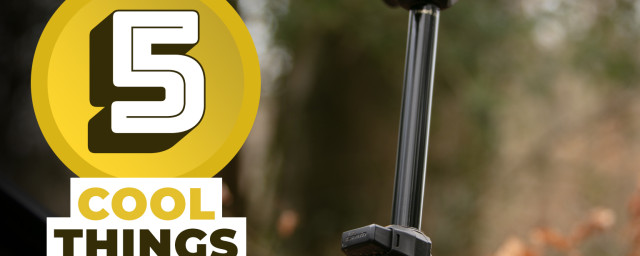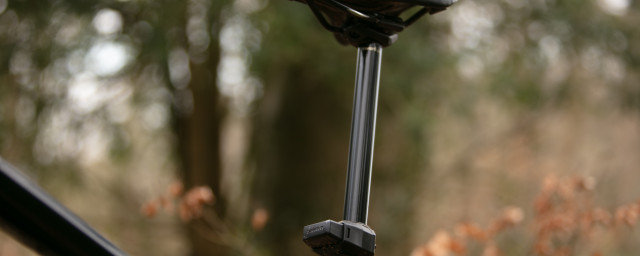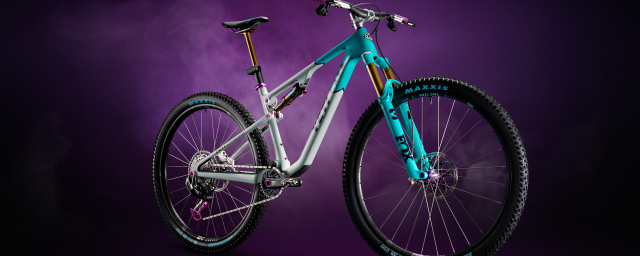Everything you need to know about off-road lights for night riding

[Updated 12.10.2021]
Tis' the season to be night riding... and for most of us, it's the only way to get out and ride during the winter months. Our bike lights buying will help you navigate the lumens, tech talk and mounting options so you can find the best lights for your night ride.
- 9 top tips to make the most of the off-road night riding season
- Gloworm Alpha front light review
- Lumicycle Apogee Extender Pack front light review
A good set of mountain bike or gravel lights makes the difference between a piece of sketchy singletrack and an epic ride without any battery anxiety. Beam patterns, lumens and fitting can make or break the performance of a bike light. Get a good set, though, and you'll be winning. Night riding feels faster and is a great way to ensure your trail skills don't decrease during winter due to the lack of daylight hours to ride.
What features make a good front light?
A suitable light for mountain biking at night needs to have sufficient power. Generally, we'd say that you should look for more than a claimed 1,500 lumens for a handlebar-mounted light. Lumens measure the total amount of visible light, so the more lumens, the brighter the light. However, this doesn't necessarily mean the brightest light will be more useful though. There are other variables at play, too, such as beam pattern and spread.
The device itself needs to be easy to use in the dark! Look for easy to press buttons or a handlebar-mounted remote that connects quickly and easily to the light. To conserve power and maximise efficiency, you'll likely need to toggle with the light settings. You want to use less power when you are climbing and more when you are descending, so altering this on the fly is really useful.
Take a look at how the light mounts to the handlebars or your helmet. We're guessing you won't want it still attached for your weekend ride in the daylight, so small, unobtrusive clamps are ideal to leave on the bike all winter long, removing just the light and battery when not in use. The Exposure bar clamps are a great example of this. The additional benefit of this is that the light beam will be at the exact perfect riding angle each time you ride; you'll never have to set it up again.
To battery pack or not to battery pack?
Front lights come in different shapes and sizes, from fully encased units for the helmet or the bars to smaller lights with external battery packs. Which you choose will come down to price and battery life. Generally, lights that do not need the external battery pack but have a good battery life are more expensive. Those that need the external packs can be more powerful as they might have larger batteries as they are not constrained on size by the shape and weight of the light unit itself.
Battery packs have the added advantage that you could buy spares and replace them easily mid-ride. Companies like MTB Batteries make batteries compatible with a range of light brands.
Helmet lights are more straightforward to use if you can stretch to one without an external battery pack. Using a helmet light with a cable and battery attached means you have to find a place to store this in a pocket, bag or attached to the helmet, which can become heavy. Bar mounted lights with an external battery are, we think, less of a faff as you can take the weight of the battery on the frame. They usually come with sturdy straps for you to attach the battery to the underside of the top tube, for example.
How to keep your batteries working at their best
We're handing this straight over to the experts. Ashton Payne from Hope Tech says, "To get the best battery life, it is generally better to use and store them in cool conditions. So, cycling at night with cool airflow during the autumn and winter months is ideal. There are occasions where lithium-ion batteries behave unpredictably during extreme cold or freezing conditions due to a 'lag' effect within the chemistry of the cells. In these cases, we advise our customers to, wherever possible, run their light via an extension cable to allow them to put the battery in a pocket or rucksack to protect it from extreme temperatures. However, this happens very rarely.
There is no need to fully discharge Li-ion batteries before recharging. They do not suffer from any 'memory effect' like some batteries, so partial discharging is fine. It is more advisable to fully charge the battery more frequently between rides than risk running out of battery life during a ride.
Storage conditions during the summer months, when the lights are not needed, are essential in maintaining battery run time and lifespan. They like to be stored in cool and dry conditions, such as a garage, away from any heat sources, at a state of charge of around 50%. Li-ion batteries do self-discharge over some time, albeit very slowly, but it is important to not let them drop into a state of 'deep discharge' as the voltage can drop to below the level that the charger is looking for when you plug it in to charge. This essentially kills the battery pack because the charger will just refuse to charge it. To avoid this, periodically charge the battery to around 70-80% and then put it back into storage. Then fully charge the battery the night before you intend to use it for the first dark ride of the autumn."
Do I need two lights?
The short and sweet answer is yes. We recommend a more powerful bar-mounted light, 2,000 lumens and up, paired with a smaller head-mounted unit of about 800 lumens. You can go much more powerful, though. Our Rach's mountain bike light set-up includes either the Lumicycle Apogee or the Gloworm XSV on the bars in conjunction with an Exposure Zenith headlight. That's 4,500 lumens on the bars with 2,000 on her head, using both lights at full power on descents and then on the least powerful setting on ascents. Mountain bike trail riders might benefit from a similar set-up to Rachael. Still, long-distance gravel or cross-country riders might find they can use less bright lights or at least utilise the same battery power on a lesser light setting that has a sustained output for longer rides.
The two lights perform different functions. The bar-mounted light provides a great deal of light in a straight line, and for the most part, it'll be this light you'll use to see where you are going. The headlight adds additional light directly where you are looking - around corners, for example. The headlight can afford to be a bit more concentrated in its pattern. It might have a slightly wider spread than the headlight to allow for greater all-around vision without wasting light on parts far off the track, though.
We asked Ashton Payne from Hope Tech about his ideal set up too; "The ideal set-up is to use a bar-mounted light coupled with a second on a helmet mount. The bar-mounted light should have a broad/wide beam to give a wash of light that doesn't necessarily need to have a long reach but distributes the lumens evenly over the immediate foreground and the hedges or verges the right-left to aid peripheral vision. The helmet-mounted light should have more of a narrow spot beam to provide a more focused beam of light to intensify the area where you are about to ride into, whether that's looking straight ahead further along the trail or as you are approaching a corner or berm you can light up the exit path."
Light sources: It's LEDs, LEDs or LEDs these days
A few years ago, you had a choice of different bulb options to consider. Still, LED lights have improved to such an extent – and come down in price too – that there really isn't a choice anymore. LEDs tick all the boxes for a bike light. They're tiny, they don't cost much to make, they last forever, they're rugged, they run fairly cool, and they're easy on the battery juice.
There are differences in LED's though, there are cheaper bulbs that you might find in flashing 'commuter lights' and also high-spec emitters in top-dollar off-road lamps. It's common to see CREE LEDs used, a brand that is a market leader in LED tech. You'll find them in Exposure lights, Lumicycle, Gloworm and many more.
What is a lumen?
Simply put, lumens measure the total amount of light visible to the human eye from a lamp or light source. The higher the lumen rating, the "brighter" the lamp will appear. As a rough guide, brighter is, of course, better; you'll see more with a 4,000 lumen light than you will with a 1,000 lumen light. It'll be easier to travel at speed with more light available, but there are more variables at play here than you might expect. Things like beam pattern, light spread and intensity also play a part.
Light beams that are too focused are not ideal for off-road riding but might be preferred by road riders. Singletrack riding requires a beam with some spread rather than a super focused beam so you can take in some of your surroundings and assess the terrain. A super intense light may reflect off objects and lead to an appearance of 'flashes' to the eyes as your ride, especially in the wet. It'll also hinder your perception of depth, something that you'll need to assess when riding more technical drops or chunkier rocky trails.
We asked an expert, this time Bruce Davey of Gloworm, for his advice on lumens. Here's what he had to say;
"Most lumen outputs and or runtimes are not accurate. When a new light comes to the market, we find out the battery capacity and LED type. Using this info, some basic physics and info found online, you can easily see if a manufacturer is overstating a specification. Lumen output can be misleading because it only describes how much light is being output from the LED-based on the power being put into the LED. How that light is used is what makes a good light.
The example I use is that lumens are like the volume of water coming from a garden hose and brightness is the equivalent to the pressure of that water. For example – when the garden hose is on a jet stream, this is the equivalent of having all the lumens focussed in one spot and therefore creating a light with a narrow beam that is very bright. Now if you take that hose nozzle and change it to a spray where the pressure is lower – this is the equivalent to a flood beam. Wider, less bright, but still the same lumens. Optic types are also something that really affects light performance, but to the untrained eye, it's not something that can be determined easily." Gloworm lights we have tested include different optics that the user can easily change to suit preference from a 'spotlight' to one with a slightly wider beam pattern.
Bruce had some advice regarding other light features too; "Management of heat is important. Some cheaper lights won't manage heat at all and will just get hot, creating a danger for the user and potentially damaging the light. Gloworm use an equilibrium system – meaning that the light senses when the temp is approaching a threshold. In preparation, it will reduce the brightness in 5% increments every 30 sec until it sees the temp increase has stopped. It will then begin to raise the brightness by the same increments toward the previous setting. It will go back and forwards until the lights have settled. 5% increments are unnoticeable to the human eye."
The final word
Choosing your lights will in some parts be down to personal choices and your riding style, battery life more than beam brightness will be a large factor here, you'll need to think about how long you ride for and how much of that time you'll need maximum light power for. Also, factor in, how often you night ride, if you are frequently using the lights then a fully integrated head-mounted light will save you set up time and mean that you won't need to ride with a bag for quick laps. If you only ride once a month in the dark, you might decide that the large expense of such a light isn't justified and a cheaper external battery pack light is sufficient.
Whilst we recommended 800 lumens for a head-mounted light and 2,000 on the bars, if you can stretch and buy more powerful lights that may be more expensive then we'd recommend that you do, especially if riding more technical trails. We have tested a range of lights and will be putting together a 'best of guide' in the very near future for anything that has scored four stars or over, check back for that soon. In the meantime, happy night riding!
















